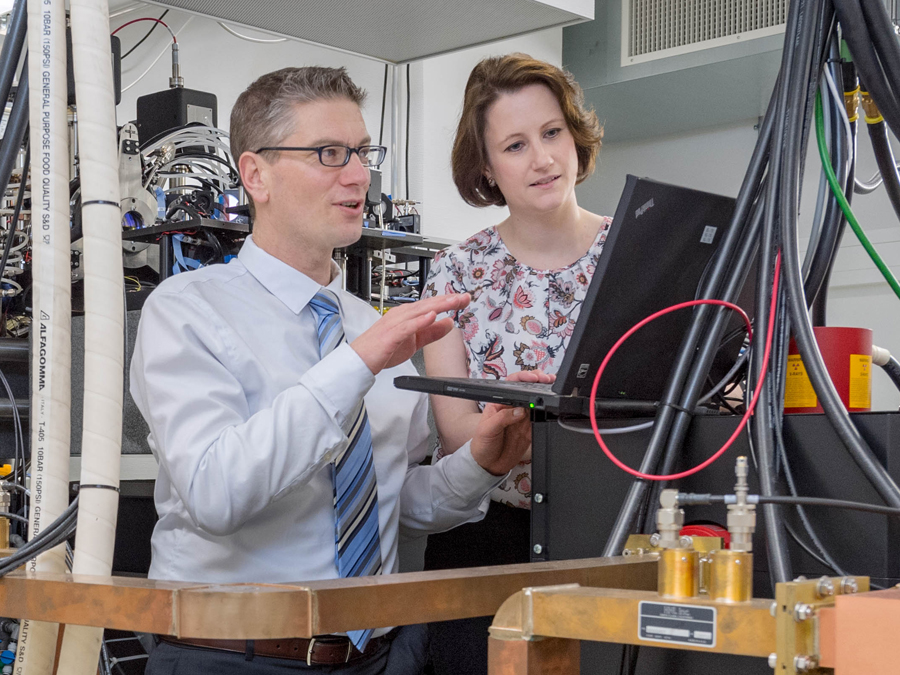Leibniz Prize winner Franz Pfeiffer to head TUM Integrative Research Center
Munich School of BioEngineering sets European standards

Founded in 2015, the Munich School of BioEngineering (MSB) is an inter-faculty Integrative Research Center accredited for supervision of Doctoral degrees and is anchored in the basic principles of the TUM. The definition of its mission follows the modern alignment of biomedical engineering towards the result and value creation chain Molecule – Organism – Patient, and is thus targeted towards key medical questions, driven by scientific research and shaped by engineering and computer sciences.
In spite of their continuing major significance, apparatus-oriented classical medical technologies (e.g. technical assistance systems) are not a core element at the MSB. Research is much more oriented towards the functionality of genes, transportation of information between cells, the processes of protein folding and the structural-mechanistic interaction of proteins. This new field of knowledge, a product of the relentless progress being made in bioscience research, is altering the direction taken by medical technologies, with the role of Big Data equal in importance to that of miniaturization and biological microscopy and imaging methods. This places cell and protein biochemistry, biological microscopy, biophysics and medical physics, semiconductor technologies and robotics at the center of the novel research area bio-engineering, bounded by natural sciences, technology development and medicines. The TUM is strong in all these areas, including Informatics as well as Applied Mathematics.
The Munich School of BioEngineering covers four research sectors:
Sensor Technologies & Biomedical Imaging
Examples:
- Opto-Acoustics as a biological imaging process using the emission of ultrasound following the absorption of laser light to depict metabolic processes.
- Phase Contrast as a high-sensitivity x-ray method in radiography and computer tomography utilizing the wave properties of x-ray radiation in the early detection of lung disease and tumors.
- Multimodal Molecular Imaging as a combined diagnostic procedure using Positron Emission Tomography (PET) and Magnetic Resonance Imaging (MRI) in simultaneously detecting anatomy, structure and metabolism in tissue.
Synthetic Biology and Biomolecular Systems
Examples:
- DNA Origami as a bottom-up synthesis procedure for generating and understanding the nature of cellular structures and mechanisms.
- Bioinformatics and Computer-Aided Biology as a predictive tool in the investigation of protein folding.
- Functional Proteome Analysis as a bioanalytical procedure for use with proteins to investigate molecular mechanisms in cases of cancer.
Biomaterials & Bio-Inspired Engineering
Examples:
- Microscopy and Micromechanical Modeling as a methodology for understanding the biological-mechanical properties of the bone-cartilage unit.
- Computer-Based Modeling as the basis for predicting blood and breath flow profiles in the context of cardio-vascular disease.
- Electrochemical Sensor Fields as a method for measuring chemical signals from cells in real-time in order to generate structured cell networks.
- Bionics, in the sense of forming an interface between nature, medicine and technology.
Biomedical Technologies
Examples:
- Cognitive Systems in multifunctional high-performance robots for improving robot-aided medicinal applications.
- Neuronal Information Processing and Nanoelectronics for improved inner-ear implants in support of the auditory system.
- Laser-Based Compact Synchrotron "Munich Compact Light Source" (MuCLS) as a source of high-brilliance x-ray radiation for microscopic investigation of biological and biomedical issues in the context of illnesses.
With the objective of establishing a scientific bio-engineering community, the former Graduate School GSISH (Information Science in Health) was thematically transformed into the TUM Graduate School of Bioengineering (GSB), which will remain under the direction of Prof. Axel Haase. The international master’s program "BioEngineering" will begin in winter semester 2018/19, combining the engineering disciplines with key questions of biology, biophysics and medicine and focusing on cancer, cardio-vascular and metabolic illnesses. The curriculum is coordinated by Leibniz Prize winner Prof. Vasilis Ntziachristos, Chair of Biological Imaging.
Leibniz Prize winner Prof. Franz Pfeiffer, Chair of Biomedical Physics, will succeed the founding director Prof. Axel Haase as the head of the MSB. Prof. Pfeiffer is an internationally recognized authority in the field of medicinal imaging processes and recently developed the mini-synchrotron MuCLS. The director will be assisted in his leadership tasks by a steering commission. The research commission, which currently includes members from eight faculties, designs the institute's research program in ongoing coordination with the associated institutions TranslaTUM (Munich), Munich Center for Functional Protein Assemblies (Garching), Bavarian NMR Center (Garching), Bavarian Biomolecular Mass Spectrometry Center (BayBioMS, Freising-Weihenstephan) and the TUM Entrepreneurship Center (Garching). The TUM Institute for Advanced Study (TUM-IAS) will support the work activities of the MSB with international top researchers, as will the EU-subsidized post-doctoral program of the TUM.
The research building built in 2001 for TUM medical technology at the Garching Campus center will serve as a location for central collaborative projects and as the street address of the MSB.